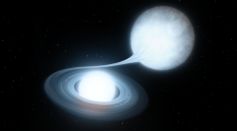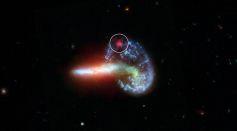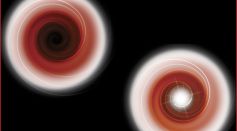Tags: Galaxy
NASA's Hubble Space Telescope Detects Ultra Weak Galactic Fossils Near Sculptor's Galaxy
Cold Planets Like Jupiter and Neptune Exist in Milky Way's Galactic Bulge; Here's What It Means
Wandering Rogue Black Holes in Milky Way Galaxy Are More Common Than Previously Thought
Supercomputer Tracks Chaotic Young Galaxies As They Mature Into Orderly Forms, New Simulation Shows
NASA's Hubble Space Telescope Shares Gorgeous 'Einstein Ring' From Quasar Planet
Cosmic Ray Instability's Possible Impact on Wide-Scale Galactic Dynamics Through Magnetic Fields Investigated
NASA’s Hubble Space Telescope Detects Stunning Image of Spiral Galaxy
Durham University Researchers Unveil Photo of Galaxies in Ultra-High Definition

Did NASA Just Find Milky Way’s Broken Arm? Scientists Claim Seeing a Cluster of Nebulae, Young Stars in the Galaxy
Biggest Curl of Gas in Space Discovery Baffles Scientists As to What Exactly Is This Structure in the Milky Way

This Supernova Shrapnel Star Is Running Away From The Galaxy, 2M Miles an Hour

Hubble, Spitzer Space Telescope Detect Stars Exploding in Hidden Galaxies
Star Moving at Lighting Speed Spotted; Scientists Say It's So Fast That It Nearly Leaves the Galaxy at 2 Million Miles an Hour

Event Horizon Telescope Detects Strong Astrophysical Jet From Black Hole; What Is It Trying To Tell?

Scientists Discover Massive Galactic Structure in Space by Accident
Are Black Holes Slowly Taking Over Star Cluster Palomar 5 Orbiting Milky Way Galaxy?
Hubble Space Telescope Finds A Galaxy That Lacks Dark Matter

Could This 3 Billion Light-Year Long Chain Overturn Cosmology?

Milky Way: Stream of Nearly 500 Stars in the Galaxy is a Family Thousands of Light-Years Away

Hubble Space Telescope Captures Spiral Galaxy NGC 691 in Stunning Detail
Most Popular

How Strong Are Tornadoes? Understanding the EF Scale and the Extreme Power Tornadoes

Glaciers Are Melting Fast: Climate Change Impact Driving Sea-Level Rise Worldwide

How Telescopes Work: Optical vs Radio vs Space Telescope Science Explained

Can the World Run Out of Water? Water Scarcity Science and Climate Impact Explained




